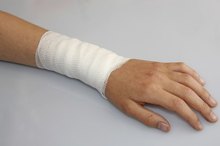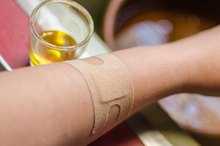What does fact checked mean?
At Healthfully, we strive to deliver objective content that is accurate and up-to-date. Our team periodically reviews articles in order to ensure content quality. The sources cited below consist of evidence from peer-reviewed journals, prominent medical organizations, academic associations, and government data.
- FamilyDoctor.org: First Aid for Burns
- MayoClinic.com: Burns: Causes
- MayoClinic.com: Burns: Lifestyle and Home Remedies
The information contained on this site is for informational purposes only, and should not be used as a substitute for the advice of a professional health care provider. Please check with the appropriate physician regarding health questions and concerns. Although we strive to deliver accurate and up-to-date information, no guarantee to that effect is made.
How to Prevent Scarring From a Steam Burn
A burn occurs when the skin is exposed to a temperature greater than 140 degrees F, according to MayoClinic.com 2. Treatment for most minor burns, including those caused by steam, is similar. The best way to avoid scarring is to provide immediate first aid to the wound. This will prevent complications that may lead to further damage of the tissue and scar formation. Problems, such as infection, are going to be the most likely cause of scarring from a minor burn. Burns that cover a large surface area or that blister and break open are not minor and will require medical treatment.
Cool the burn immediately by immersing the area in room temperature water. Push the burned skin under running water or fill a container to submerge the area. Do not place ice on the wound. The nature of burns may make it difficult to tell when the area becomes too cold and begins to freeze. Room temperature water is the best choice to cool and stop the burn.
How to Heal a Light Skin Burn
Learn More
Look closely at the burn to determine the extent of the damage. If the area does not blister but remains red or pink, this is probably a first-degree burn and will not need to be evaluated by a medical professional. Burns that cover large areas, even if it is just a first degree burn, should be looked at by a doctor. For example, a steam burn that covers the entire surface of your arm is more serious than a burn the size of a quarter.
Apply a light cream or aloe gel to the burn. Avoid using any solution that is greasy or heavy. Do not apply an ointment or butter to the area. MayoClinic.com states that butter will hold in the heat and cause the burning to continue 2.
How to Treat a Burn Bubble
Learn More
Cover the wound with a sterile bandage to help prevent infection and reduce pain. Place the gauze square over the burn loosely and use paper tape to secure it.
Remove the bandage after 24 hours and look at the burned site again. If the area has blistered or has discharge, go to the doctor. Burns can open skin and introduce infection. Reapply cream and cover the area with a new bandage as long as the skin is not open.
Tips
If necessary, take an over-the-counter medication to manage pain. Burns can hurt, even first degree.
Warnings
Avoid touching or picking at the damaged skin. Leave the bandage on as long as air hitting the area increases the pain. Minor burns should stop hurting within a few days.
Related Articles
References
- FamilyDoctor.org: First Aid for Burns
- MayoClinic.com: Burns: Causes
- MayoClinic.com: Burns: Lifestyle and Home Remedies
- Knowlin, L., Stanford, L., Moore, D., Cairns, B., & Charles, A. (2016). The Measured Effect Magnitude of Co-Morbidities on Burn injury Mortality. Burns : Journal of the International Society for Burn Injuries, 42(7), 1433–1438. http://doi.org/10.1016/j.burns.2016.03.007
- Hilton G. Thermal Burns: The ABCs are crucial, since the major threat is often inhalation injury. Am J Nurs. 2001;101(11):32-34. doi:10.1097/00000446-200111000-00017
- Cleveland Clinic. Burns. Updated August 31, 2017.
- Thom D. Appraising current methods for preclinical calculation of burn size - A pre-hospital perspective. Burns. 2017;43(1):127-136. doi: 10.1016/j.burns.2016.07.003.
- Knowlin, L., Stanford, L., Moore, D., Cairns, B., & Charles, A. (2016). The Measured Effect Magnitude of Co-Morbidities on Burn injury Mortality. Burns : Journal of the International Society for Burn Injuries, 42(7), 1433–1438.
Writer Bio
Writing since 1999, Darla Ferrara is an award-winning author who specializes in health, diet, fitness and computer technology. She has been published in "Mezzo Magazine" and Diet Spotlight, as well as various online magazines. Ferrara studied biology and emergency medical technology at the University of Nebraska and Southeast Community College.







